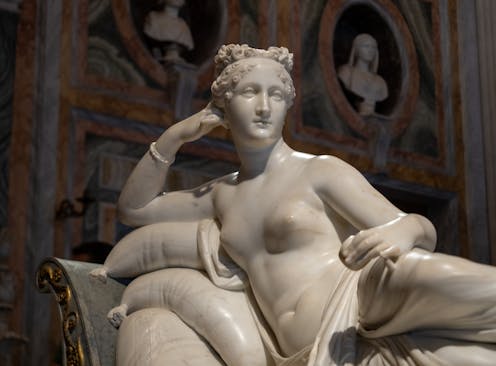Women have been excluded from men’s spaces for centuries. And that’s why the MONA Ladies Lounge matters
- Written by Catharine Lumby, Professor of Media, Department of Media, University of Sydney

Gender, class, race, culture and religion are all categories used to exclude people in ways that privileged people will never experience. This exclusion can be as blatant as a gang of masked people performing the Nazi salute, or as subtle as an upper-middle-class golf club quietly binning membership applications from Jews or Muslims.
The question of how we redress these exclusions is once again in the news because of a legal case taken up against Hobart’s contemporary art gallery, MONA. The anti-discrimination case has been launched on the basis that it contains a women-only Ladies Lounge art installation created by Kirsha Kaechle, an artist who is also married to the museum’s founder, David Walsh.
Jason Lau brought the complaint because he had been denied access to the space, which features works by Pablo Picasso and Sidney Nolan, on account of his gender. Kaechle said she is “delighted” the anti-discrimination complaint has ended up in Tasmania’s Civil and Administrative Tribunal.
“The men are experiencing Ladies Lounge, their experience of rejection is the artwork,” she said.
“OK, they experience the artwork differently than women, but men are certainly experiencing the artwork as it’s intended.”
Whatever decision the tribunal hands down, these recent events remind us that women still struggle to claim a small slice of the pie men have claimed for centuries.
A history of keeping women out
As a kid in primary school, growing up in Newcastle – a working-class beachside town – I was occasionally asked by my Nanna to head down to the local pub in my PJs and give my Granddad a nudge to come home for dinner.
Until 1965, women were excluded from public bars. A few bars would let them drink in the “ladies lounge”, which would confine them to a small area and often charge them more for drinks than men.
Even so, working-class women had little time to lounge. Most worked menial jobs while also doing all the domestic labour.
Because I was a kid, I was warmly received at the Bennett Hotel and would sit up at the bar with a raspberry lemonade. The men – most of whom had knocked off at 4pm from working on the docks or at BHP – were seriously drunk by 6pm.
Today, there are still prestigious clubs across Australia that exclude women, the Melbourne Club being a notorious example. Even if they don’t explicitly ban women from being members, they are male-dominated by their very nature. Membership relies on being “the right sort of chap”: someone who went to the right school and university and rose up the ranks.
Men have controlled parliaments, the corporate sector and now claim dominion over big tech. It’s no skin off their collective noses if women have a room to gather and drink tea or a glass of wine.
Why women’s spaces matter in art
There’s a good reason women might want to hang out in a space where they feel comfortable. At the sharp end, there are women who are survivors of sexual assault and domestic violence. On average one woman is killed every nine days by an intimate partner.
Beyond that, the Ladies Lounge is an apt subversion of a throughline that has dominated the art world for centures: art is made for the male gaze. Even though art galleries are public spaces, they have been overwhelmingly stocked with work by male artists, many of whom have built careers painting female nudes designed for the male gaze.
Art historian Kenneth Clarke (1903-83) described a female nude this way:
By art, Boucher has allowed us to enjoy her with as little shame as she is enjoying herself.
Really, Kenneth?
In 1989, American activist art group Guerrilla Girls found fewer than 5% of the artists in the modern art section of New York’s Metropolitan Museum of Art were women, yet 85% of the nudes were of women. By 2012, these numbers had barely shifted: fewer than 4% of the artists were women, while 76% of the nudes were of women.
Women walk through the world with an enormous cultural weight simply because they are women. The sexy young woman. The maternal saintly body. The invisible older woman. This is why women’s spaces matter, and why women should be able to choose whether, when and how they can be seen.
One of my favourite Australian contemporary artists is Julie Rrap who, with extraordinary talent and wit, uses her body to make art that returns the male gaze. Since the 1980s, she has been producing photographs, videos and sculptures that play with the female form in a way that subverts the tradition of the classical nude in Western art.
Rrap’s work is a classic example of a woman artist reclaiming space in a traditional male setting: the art museum.
Ways to go
My last word goes to Emma Jones, a young woman who is completing her honours thesis at Sydney University on these very questions. Asked whether women’s spaces were still relevant, she said:
The world is still dominated by men trying to speak on behalf of women. Social media has given a powerful platform to a fresh wave of men attempting to ‘educate’ other men about what women ‘really’ want. The need for women to meaningfully connect with other women, feel heard and develop their voice is just as relevant today as it’s always been.
I’m with you on that, babe. When you become the leader of a women-dominated federal government, I look forward to seeing you support a bill to set up a men’s space in Parliament House. I’ll be catching up with you in the members’ bar.
Read more: Why weren't there any great women artists? In gratitude to Linda Nochlin
Authors: Catharine Lumby, Professor of Media, Department of Media, University of Sydney



